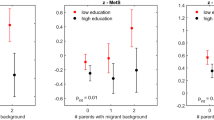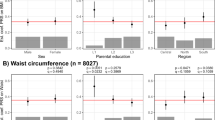Abstract
Background/objectives:
Although there are some studies on familial clustering of metabolic risk factors, there are few on clustering of diet and physical activity. The aim of this study was to identify the extent of familial clustering of weight status, diet and physical activity in urban and rural families in South India.
Subjects/methods:
Anthropometric, dietary and physical activity data were obtained for 325 offspring aged 8–21 years and both their parents from urban and rural South India. However, 294 single offspring and their parents were used for analysis. Body mass index (BMI) was computed and individuals categorized as normal, underweight and overweight/obese. Diet was assessed using food frequency questionnaires and physical activity using physical activity questionnaires.
Results:
Offspring BMI correlated significantly (P<0.001) with the BMIs of both parents (r=0.35, P<0.001). Percent protein, carbohydrate, total fat and saturated fat intakes were significantly correlated (P<0.001) between offspring and parents. Offspring physical activity level (PAL) correlated significantly with the mother (r=0.26, P<0.001), but not the father. A two-step cluster analysis revealed two distinct clusters: obesogenic and nonobesogenic. The obesogenic cluster, which consisted of 83% of families with at least one parent or offspring overweight, had significantly higher intakes of fat, saturated fat and higher sedentary activity levels but lower carbohydrate intakes and sleep duration (all P<0.001) among both offspring and parents.
Conclusions:
Diet, physical activity and BMI of children, adolescents and young adults in India is associated with parental behavior. Health promotion aimed at reducing obesity in these groups should address familial issues.
This is a preview of subscription content, access via your institution
Access options
Subscribe to this journal
Receive 12 print issues and online access
$259.00 per year
only $21.58 per issue
Buy this article
- Purchase on Springer Link
- Instant access to full article PDF
Prices may be subject to local taxes which are calculated during checkout



Similar content being viewed by others
References
Pérusse L, Tremblay A, Leblanc C, Cloninger CR, Reich T, Rice J et al. Familial resemblance in energy intake: contribution of genetic and environmental factors. Am J Clin Nutr 1988; 47: 629–635.
Faith MS, Keller KL, Johnson SL, Pietrobelli A, Matz PE, Must S et al. Familial aggregation of energy intake in children. Am J Clin Nutr 2004; 79: 844–850.
Davison KK, Birch LL . Obesigenic families: parents’ physical activity and dietary intake patterns predict girls’ risk of overweight. Int J Obes Relat Metab Disord 2002; 26: 1186–1193.
Pérusse L, Tremblay A, Leblanc C, Bouchard C . Genetic and environmental influences on level of habitual physical activity and exercise participation. Am J Epidemiol 1989; 129: 1012–1022.
Rhee K . Childhood overweight and the relationship between parent behaviors, parenting style, and family functioning. Ann Am Acad Pol Soc Sci 2008; 615: 12–37.
Cameron AJ, Crawford DA, Salmon J, Campbell K, McNaughton SA, Mishra GD et al. Clustering of obesity-related risk behaviors in children and their mothers. Ann Epidemiol 2011; 21: 95–102.
Eriksson J, Forsen T, Tuomilehto J, Osmond C, Barker D . Size at birth, childhood growth and obesity in adult life. Int J Obes Relat Metab Disord 2001; 25: 735–740.
Wright CM, Parker L, Lamont D, Craft AW . Implications of childhood obesity for adult health: findings from thousand families cohort study. BMJ 2001; 323: 1280–1284.
Kelder SH, Perry CL, Klepp KI, Lytle LL . Longitudinal tracking of adolescent smoking, physical activity, and food choice behaviors. Am J Public Health 1994; 84: 1121–1126.
Fuemmeler BF, Pendzich MK, Tercyak KP . Weight dietary behavior, and physical activity in childhood and adolescence: implications for adult cancer risk. Obes Facts 2009; 2: 179–186.
Dietz WH . Health consequences of obesity in youth: childhood predictors of adult disease. Pediatrics 1998; 101 (3 Pt 2), 518–525.
Raitakari OT, Juonala M, Kahonen M, Taittonen L, Laitinen T, Maki-Torkko N et al. Cardiovascular risk factors in childhood and carotid artery intima-media thickness in adulthood: the Cardiovascular Risk in Young Finns Study. JAMA 2003; 290: 2277–2283.
Semmler C, Ashcroft J, van Jaarsveld CH, Carnell S, Wardle J . Development of overweight in children in relation to parental weight and socioeconomic status. Obesity (Silver Spring) 2009; 17: 814–820.
Burke V, Beilin LJ, Dunbar D . Family lifestyle and parental body mass index as predictors of body mass index in Australian children: a longitudinal study. Int J Obes Relat Metab Disord 2001; 25: 147–157.
Pankow JS, Jacobs DR, Steinberger J, Moran A, Sinaiko AR . Insulin resistance and cardiovascular disease risk factors in children of parents with the insulin resistance (metabolic) syndrome. Diabetes Care 2004; 27: 775–780.
Labayen I, Ruiz JR, Ortega FB, Loit H-M, Harro J, Veidebaum T et al. Intergenerational cardiovascular disease risk factor involve both maternal and paternal BMI. Diabetes Care 2010; 33: 894–900.
Kwiterovich PO . Recognition and management of dyslipidemia in children and adolescents. J Clin Endocrinol Metab 2008; 93: 4200–4209.
Maffeis C, Talamini G, Tato L . Influence of diet, physical activity and parent's obesity on children's adiposity: a four year longitudinal study. Int J Obes Relat Metab Disord 1998; 22: 758–764.
Griffiths PL, Bentley ME . The nutrition transition is underway in India. J Nutr 2002; 131: 2692–2700.
Teo K, Chow CK, Vaz M, Rangarajan S, Yusuf S . The Prospective Urban Rural Epidemiology (PURE) study: examining the impact of societal influences on chronic noncommunicable diseases in low-, middle-, and high-income countries. Am Heart J 2009; 158: 1–7 e1.
Deschamps V, de Lauzon-Guillain B, Lafay L, Borys JM, Charles MA, Romon M . Reproducibility and relative validity of a food-frequency questionnaire among French adults and adolescents. Eur J Clin Nutr 2009; 63: 282–291.
Rockett HR, Breitenbach M, Frazier AL, Witschi J, Wolf AM, Field AE et al. Validation of a youth/adolescent food frequency questionnaire. Prev Med 1997; 26: 808–816.
Swaminathan S, Thomas T, Kurpad AV, Vaz M . Dietary patterns in urban school children in South India. Indian Pediatr 2007; 44: 593–596.
Vaz M, Bharathi AV, Thomas T, Yusuf S, Kurpad AV . The repeatability of self reported physical activity patterns in rural South India. Asia Pac J Clin Nutr 2009; 18: 71–75.
Swaminathan S, Selvam S, Tinku T, Kurpad AV, Vaz M . Longitudinal trends in physical activity patterns in selected urban South Indian school children. Indian J Med Res 2011; 134: 174–180.
Ridley K, Ainsworth BE, Olds TS . Development of a compendium of energy expenditures for youth. Int J Behav Nutr Phys Act 2008; 5: 45.
Food and Agriculture Organization. Human Energy Requirements. Report of a Joint FAO/WHO/UNU Expert Consultation. Food and Nutrition Technical Report Series. FAO: Rome, 2004.
Vaz M, Karaolis N, Draper A, Shetty P . A compilation of energy costs of physical activities. Public Health Nutr 2005; 8: 1153–1183.
de Onis M, Onyango AW, Borghi E, Siyam A, Nishida C, Siekmann J . Development of a WHO growth reference for school-aged children and adolescents. Bull World Health Organ 2007; 85: 660–667.
Bharathi AV, Kurpad AV, Thomas T, Yusuf S, Saraswathi G, Vaz M . Development of food frequency questionnaires and a nutrient database for the Prospective Urban and Rural Epidemiological (PURE) pilot study in South India: methodological issues. Asia Pac J Clin Nutr 2008; 17: 178–185.
Bharathi AV, Sandhya N, Vaz M . The development & characteristics of a physical activity questionnaire for epidemiological studies in urban middle class Indians. Indian J Med Res 2000; 111: 95–102.
SPSS. The SPSS Twostep Cluster Component. SPSS Inc: USA, 2001.
Nguyen VT, Larson DE, Johnson RK, Goran MI . Fat intake and adiposity in children of lean and obese parents. Am J Clin Nutr 1996; 63: 507–513.
Kowaleski-Jones L, Brown BB, Fan JX, Smith KR, Zick CD . Are you what your mother weighs? Evaluating the impact of maternal weight trajectories on youth overweight. Matern Child Health J 2009; 14: 680–686.
Kral TV, Rauh EM . Eating behaviors of children in the context of their family environment. Physiol Behav 2010; 100: 567–573.
Moore LL, Lombardi DA, White MJ, Campbell JL, Oliveria SA, Ellison RC . Influence of parents’ physical activity levels on activity levels of young children. J Pediatr 1991; 118: 215–219.
Oliveria SA, Ellison RC, Moore LL, Gillman MW, Garrahie EJ, Singer MR . Parent-child relationships in nutrient intake: the Framingham Children’s Study. Am J Clin Nutr 1992; 56: 593–598.
Franks PW, Ravussin E, Hanson RL, Harper IT, Allison DB, Knowler WC et al. Habitual physical activity in children: the role of genes and the environment. Am J Clin Nutr 2005; 82: 901–908.
Hill JO, Melanson EL, Wyatt HT . Dietary fat intake and regulation of energy balance: implications for obesity. J Nutr 2000; 130: 284S–288S.
Astrup A . Carbohydrates as macronutrients in relation to protein and fat for body weight control. Int J Obes 2006; 30: S4–S9.
Chhatwal J, Verma M, Riar SK . Obesity among pre-adolescent and adolescents of a developing country (India). Asia Pac J Clin Nutr 2004; 13: 231–235.
Shah P, Misra A, Gupta N, Hazra DK, Gupta R, Seth P et al. Improvement in nutrition-related knowledge and behaviour of urban Asian Indian school children: findings from the ‘Medical education for children/Adolescents for Realistic prevention of obesity and diabetes and for healthy aGeing’ (MARG) intervention study. Br J Nutr 2010; 104: 427–436.
Acknowledgements
We acknowledge the Director, Dr Auburn Jacob of the Emmaus Hospital, Palamaner, India, for facilitating the study in the rural area and all the participants of the study, the field supervisor, Jayachitra Krishnaswamy Gajendran, and all field staff involved in the data collection and entry. We also acknowledge Sumathy Rangarajan and assistance from the Population Health Research Institute (PHRI), Hamilton, Canada. The PURE study was approved by the Government of India, Ministry of Health Screening Committee (No. 50/9/Indo-CVD/05-NCD-II dt 17.4.2007).
Author information
Authors and Affiliations
Corresponding author
Ethics declarations
Competing interests
The authors declare no conflict of interest.
Additional information
Contributors: SS contributed to the design of the study, management of data collection, analysis and interpretation of data as well as led the writing of the manuscript; TT analyzed the data and interpreted the results and critically reviewed the drafts; SY contributed to the concept and design of the study and critically reviewed the drafts; MV contributed to the concept and design of the study, analysis and interpretation of the data and critically reviewed the drafts and the final manuscript.
Rights and permissions
About this article
Cite this article
Swaminathan, S., Thomas, T., Yusuf, S. et al. Clustering of diet, physical activity and overweight in parents and offspring in South India. Eur J Clin Nutr 67, 128–134 (2013). https://doi.org/10.1038/ejcn.2012.192
Received:
Revised:
Accepted:
Published:
Issue Date:
DOI: https://doi.org/10.1038/ejcn.2012.192
Keywords
This article is cited by
-
The Vermont Family Based Approach in Primary Care Pediatrics: Effects on Children’s and Parents’ Emotional and Behavioral Problems and Parents’ Health-Related Quality of Life
Child Psychiatry & Human Development (2022)
-
Unhealthy Weight in Indian Families: The Role of the Family Environment in the Context of the Nutrition Transition
Population Research and Policy Review (2018)
-
Factors influencing implementation dose and fidelity thereof and related student outcomes of an evidence-based national HIV prevention program
Implementation Science (2015)



